Table of Contents
Introduction
Here we have two seemingly great multi purpose bars with similar specs, both suitable for a garage gym or commercial gym, and for powerlifting or olympic lifting. How do you pick between them?
To elaborate, these two Rogue bars use the same exact steel shaft, same dimensions, same medium knurling cut and pattern, same warranty, and both made in the USA.
This makes the few differences really stand out. I’m elaborating on those here in painstaking detail.
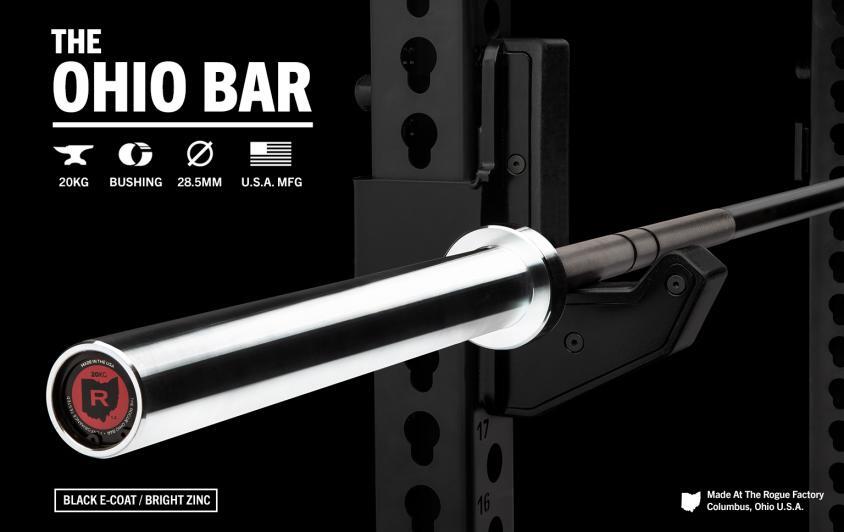
The Ohio Bar was the first bar that Rogue manufactured at their facility in Columbus, OH. It has become the most popular bar, spawning several finish options that I’m going over below.
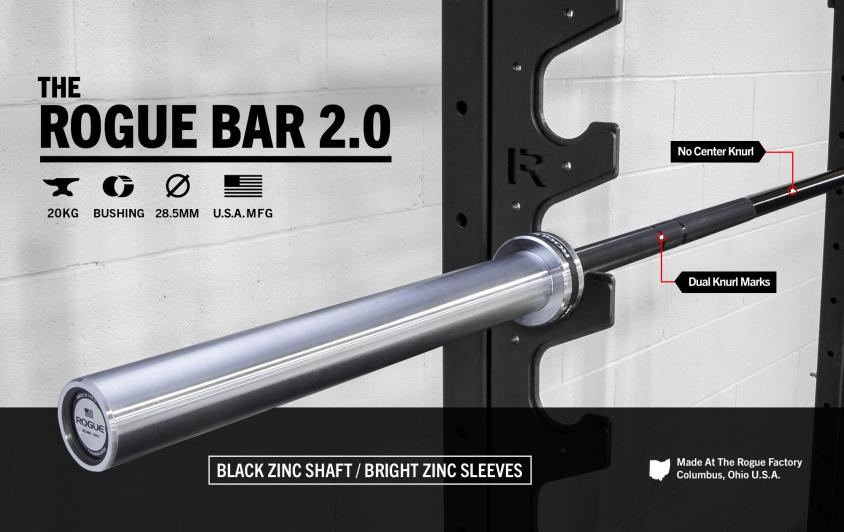
The original Rogue Bar was made by someone else for Rogue, which is the way most companies work. As Rogue’s sales volume blew up, they invested in the equipment, space, and experts to start making everything in-house. So version 2 of the Rogue Bar, along with many other bars, is made in their own facility. I don’t remember what the first Rogue Bar’s specs were.
First, let’s take a look at the finish options…
Rogue Bar 2.0 Finish
Black zinc shaft and bright zinc sleeves. Take it or leave it. No other options are available for this bar.
Zinc is a good coating that helps resist corrosion. It will scratch off on your rack if you don’t use J-hooks with UHMW liners.
The zinc on the sleeves will scratch also. With bright zinc it’s not as noticeable, being only a slightly different color than the bare steel underneath.
Ohio Bar Finish Options
As of writing the Ohio Bar finish options are e-coat, black oxide, black zinc, stainless steel, and cerakote.
Stainless steel is the best, functionally speaking. It’s also expensive. It has the tackiness of bare steel in your hands. Any coating fills in the knurling at least a tiny bit. Stainless steel is not a coating but a type of steel, and therefore the knurling remains as effective as possible. Plus, stainless steel has the best corrosion resistance of all options.
I described black zinc above for the Rogue Bar 2.0.
Black oxide is a thinner coating than zinc, meaning it will not fill in the knurling as much. This is good. Like zinc, it can scratch pretty easily, and it can rub off the easiest of all the finishes just from the wear against your hands or body, which is not good. Like bare steel, black oxide has no corrosion resistance and requires some periodic maintenance. It’s a finish that’s mostly used in applications where they don’t want the coating to affect the dimensions of a part and where it’s covered with oil. Oil sticks to this coating better than bare steel, so it’s potentially guards against corrosion better if you oil it.
Cerakote is a very durable coating that does not wear off as easily as zinc or black oxide. The only thing that will rub it off is steel J-hooks of a rack. It’s used by gun manufacturers. It’s basically a trademarked type of ceramic coating. I wrote about it a bit here. Cerakote is the only coating that can be applied as a custom logo on your bar shaft.
E-coat, or electro-coating, is a comparatively environmentally-friendly coating. The production creates little or no HAPS (Hazardous Air Pollutants) or VOCs (Volatile Organic Compounds). This stuff is very thin, like black oxide, but with better corrosion resistance. The thin layer, unlike black oxide, is applied in a way where it is evenly applied without build-up in crevices such as in knurling. It’s used a lot on car parts because of that feature. This is the newest coating they are using, so we’ll see how well it performs over time.
The Ohio Bar’s Bronze Bushings
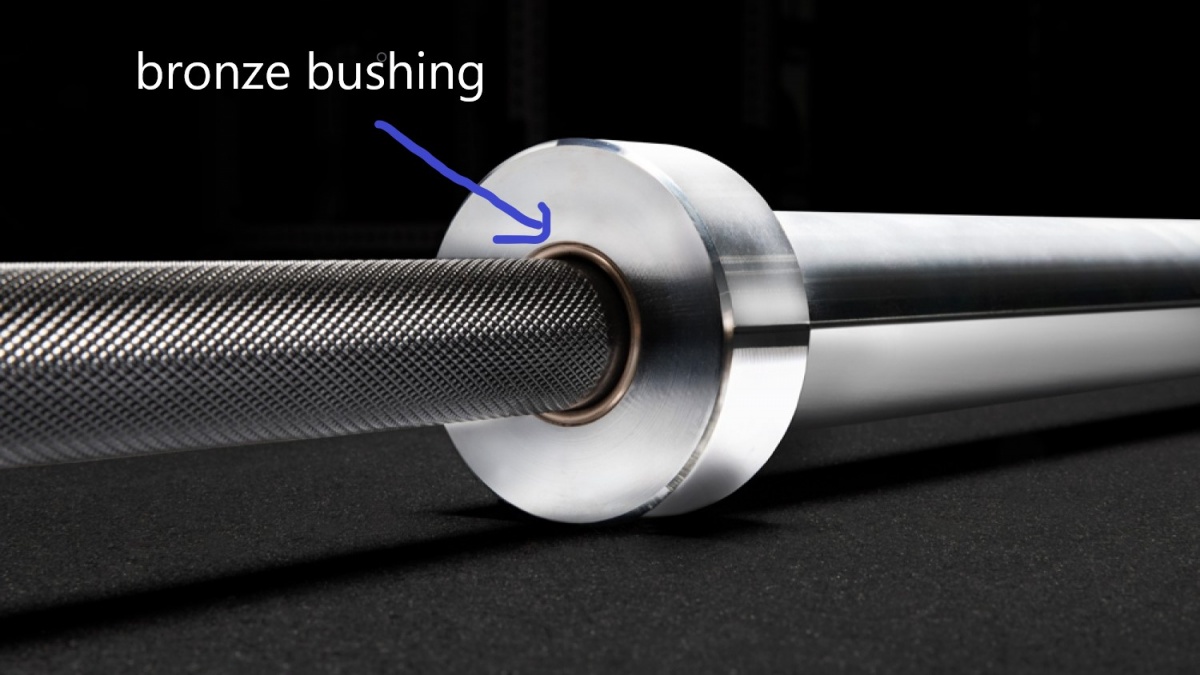
The Ohio Bar comes with bronze bushings, while the Rogue 2.0 Bar has composite bushings, which is a newer trend with barbells.
You may wonder, why are so many bushings bronze? Why not copper, steel or some other metal?
First, bronze has low friction against steel. Two different metals sliding against each other produce less friction than two of the same metal. I don’t know, that’s just how the physics work. That rules out steel bushings on a steel bar. If you really care, there’s more info about that here.
If you compare the friction coefficients of different metals, you’ll find that bronze on steel is the lowest, ie: the best.
Second, bronze is nearly as hard as steel. This means it will spin good not only one day 1, but unlike softer metals like copper it will take repeated pounding from getting dropped and continue to spin just as well.
Third, bronze has a pretty good resistance to corrosion. The low friction goes out the window if you’re using a metal that rusts from a drop of sweat getting in there.
All these factors make bronze a good choice for bushings, not only on barbells but throughout industrial applications.
This all comes under the condition that some lubricant is used between the bronze and steel. Typically teflon grease is used because it does not drip out of the sleeve like oil can. But oil is sometimes still used too. Offhand I don’t know what Rogue uses.
If your new bronze-bushing barbell doesn’t spin well, it probably wasn’t well lubricated. That’s outside the scope of this post. You can read more about adding grease or oil here.
Note that the Ohio Bar with cerakote finish has composite bushings, unlike the rest of the Ohio Bars.
The Rogue 2.0 Bar’s Composite Bushings
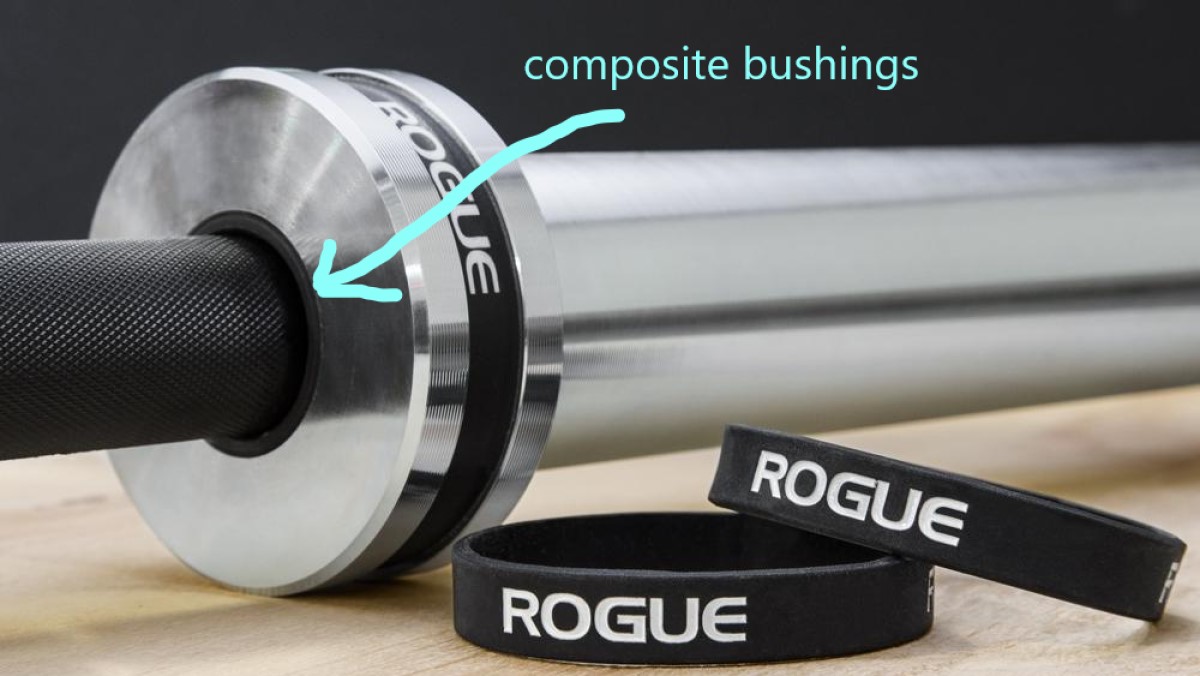
Composite bushings are a newer type that Rogue and others have started using. I don’t know exactly what they’re made out of, but it’s a mix creating a durable plastic. Composite bushings are used in serious applications like aerospace.
My understanding is that composite bushings are a little more expensive than bronze, but at high production volume maybe it’s not the case.
One functional advantage of composite bushings is they are such low friction that they don’t have to be lubricated. Add some oil or grease and they’ll be even better, but I don’t know that Rogue even includes any. This cuts down on maintenance. The lack of oil or grease may even be a plus. If you want oil in here, you can send a few drops down into the sleeve and rotate it around to get it worked in there, without worrying about the possibility of two disparate compounds (oil and grease) ending up in your sleeve.
A composite is inherently anti-corrosion, as there’s no metal. It will fare far better than bronze when repeatedly exposed to sweat or other moisture. This could extend the barbell’s life.
The composite bushings they use are very hard and will not scratch, crack, or bend.
For noise, composite wins hands-down. If you drop your bar a lot, some of the sound you hear is the bronze bushings clanging in the sleeves. A composite against steel sleeves just won’t make that level of noise, a significant plus.
As far as real-world tests, I’ve read conflicting results from people reporting the spin of composite bushings vs bronze bushings. I think some of this comes down to lubrication or how well the sleeves were designed or assembled, or possible imperfections with some of them.
Overall, you’ll be fine with either bushing type. Rogue has plenty of funds that they put into R&D and quality control, and at this stage they would not put out a product with composite bushings without plenty of testing and research. This is in contrast to smaller companies that try out a new product with zero testing and have to revise it shortly afterwards because of so many complaints. It’s why people trust Rogue’s quality over some other companies and are willing to spend a little more to avoid a disaster.
The Rogue 2.0 Bar’s Silicone Bands
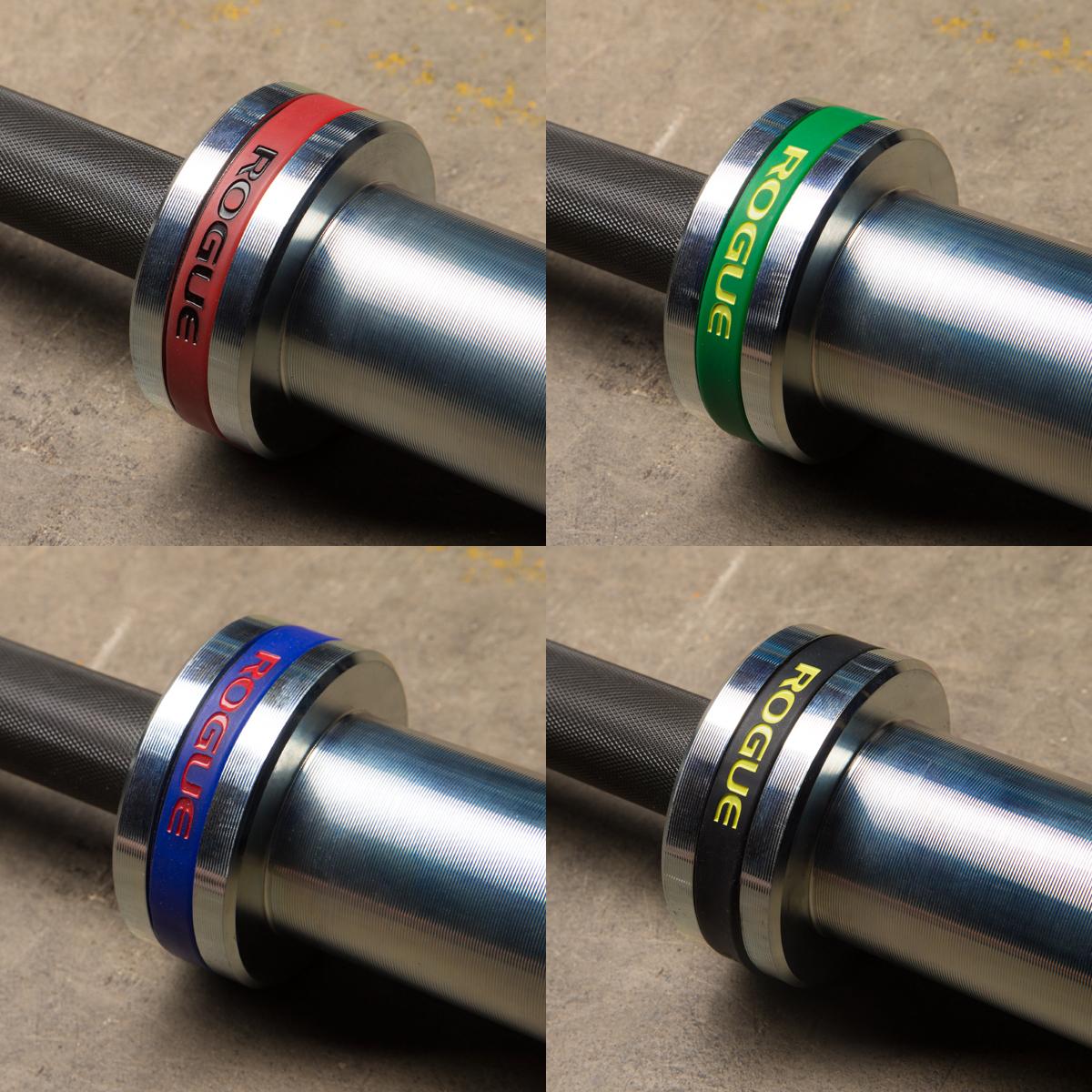
The Rogue 2.0 comes with a silicone band/bracelet option on the shoulder, in your choice of color. This is purely for identification purposes. Home and commercial gyms have a lot of bars, and this can help. Even more so it can make it obvious if a lifter has a personal bar that nobody else is supposed to use. You could even replace the bands with your own custom ones.
Price (& Links to All Versions)
Rogue Bar 2.0 – $290
The Ohio Bar versions are all listed as different products on Rogue’s site:
Stainless Steel Ohio Bar – $355
Ohio Bar with Black Zinc – $295
Ohio Bar with Black Oxide – $310
Ohio Bar with Cerakote – $355 (this is the only Ohio Bar with composite bushings – Thanks Jay!)
Ohio Bar with Cerakote Custom Logo – $335
Ohio Bar with E-Coat – $295
Boneyard Bars
Here’s a way to save some money if you’re not OCD.
Rogue sometimes has a limited stock of “Boneyard” Bars, which may include Ohio Bars and Rogue 2.0 Bars. These are all functionally great and just have enough imperfections that Rogue sells them discounted.

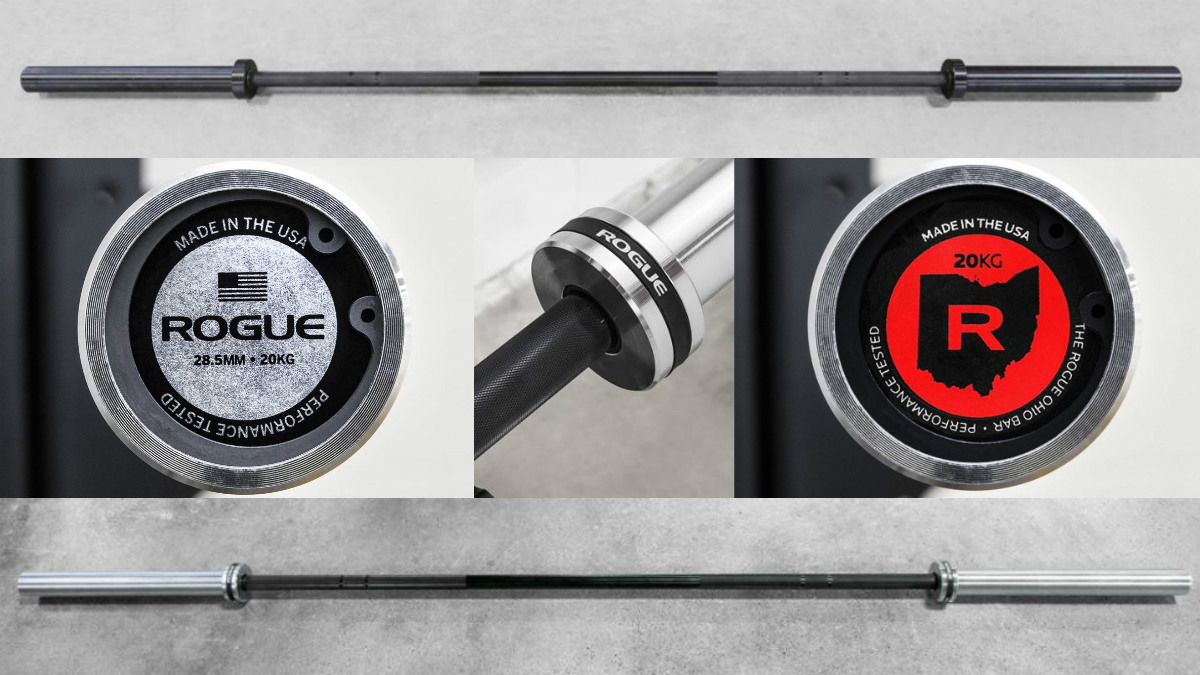
It looks like on Rogue website that the 2.0 bar shaft is e-coat not Black Zinc
They must be moving things from zinc to e-coat. I’ll get it updated, thanks!
The Ohio cerakote bar does come with composite bushings not the bronze found on all other Ohio bars. Thought that might be worth noting.
I see you’re right! I will get it updated. I wonder why they did it only on the cerakote one. The newer ecoat one has bronze.